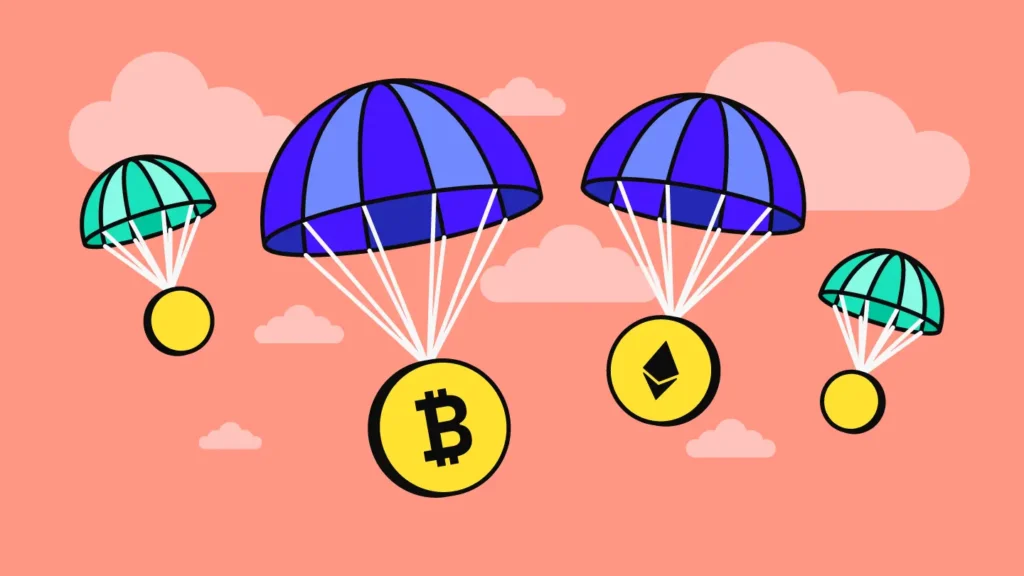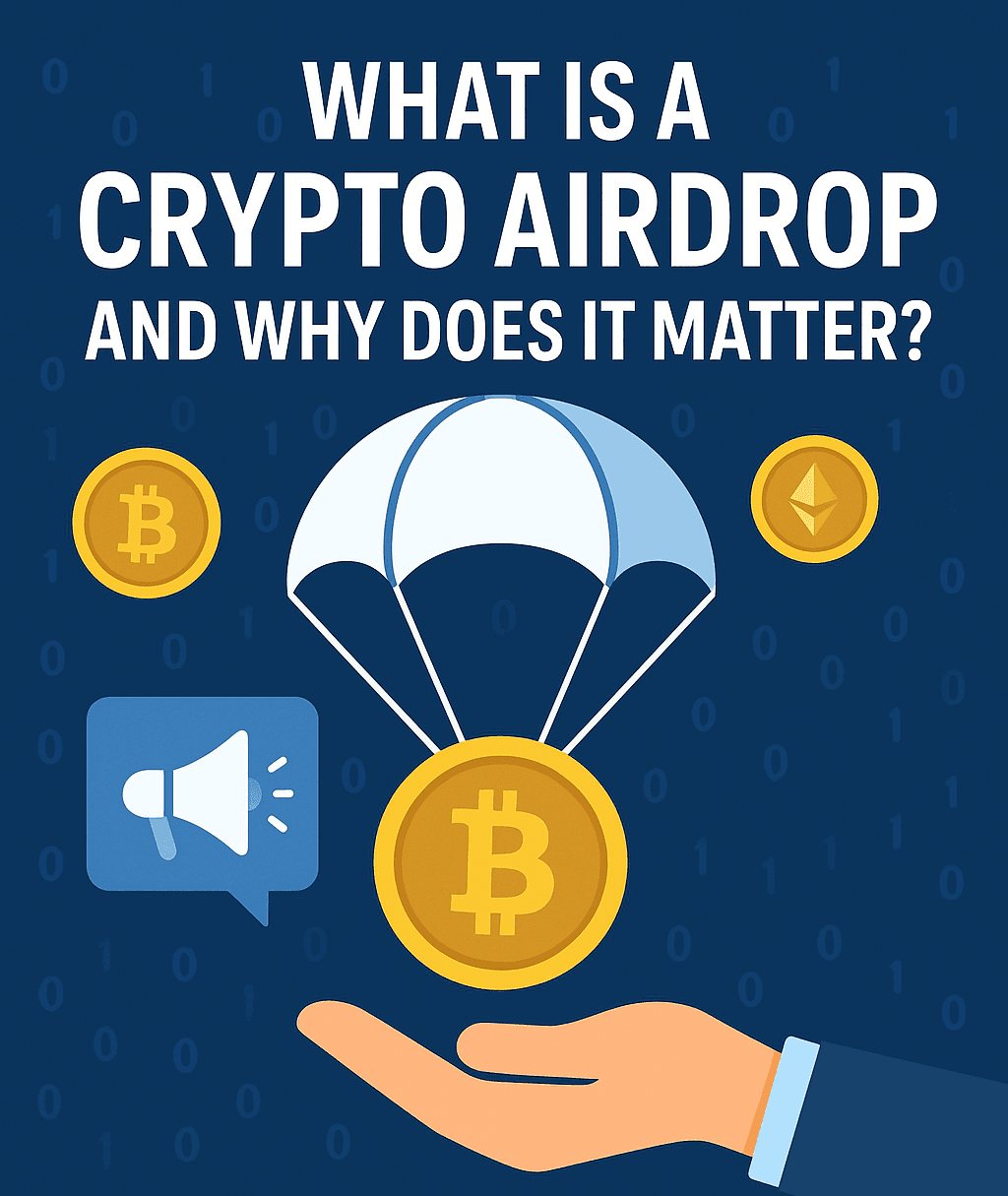I still remember the day I received the Uniswap airdrop. 400 UNI tokens appeared in a wallet I used for a few simple test swaps. At the time, they weren’t worth much. But as the protocol grew, their value skyrocketed to over $12,000. It felt like magic, but it wasn’t. It was a reward for being an early user of a new technology. This experience taught me a powerful lesson: what is a crypto airdrop? It’s one of the most unique and powerful tools in the Web3 ecosystem, but it’s also a landscape filled with risks.
If you’re asking, “what is an airdrop in crypto?” you’re in the right place. I’ve been navigating this space for years, receiving legitimate rewards and dodging countless scams. In this guide, I’ll break down everything you need to know, sharing my personal experiences to help you understand not just the “what,” but the “how” and the “why”—and most importantly, how to stay safe.
Disclaimer: This article is for informational purposes only and does not constitute financial or tax advice. The world of cryptocurrency is highly volatile and risky. Airdrops can be associated with scams that may lead to a total loss of your funds. Always conduct your own thorough research (DYOR) and consult with a qualified financial advisor and tax professional before making any decisions.
My Golden Rules for Airdrop Safety
Before we go any further, these are the non-negotiable rules I personally follow. I learned some of these the hard way, with a few close calls early in my career.

- Use a “Burner” Wallet: I never, ever interact with a new or unverified protocol using my main wallet where I store my primary assets. I have a separate wallet for airdrop hunting that only contains the small amount of funds needed for transaction fees.
- Never Share Your Seed Phrase: Your 12 or 24-word seed phrase is the master key to all your crypto. No legitimate project, admin, or support team will ever ask for it. Anyone who does is a thief. Period.
- Verify, Then Trust: I never click on links from Discord DMs, Twitter replies, or unsolicited emails. I always go directly to the project’s official, verified Twitter profile or website to find official links.
- If It’s Too Good to Be True, It’s a Scam: A pop-up promising a free “bitcoin airdrop” worth $5,000 just for connecting your wallet is 100% a scam designed to drain your funds. Real airdrops reward past actions, they don’t offer instant riches for a single click.
A Beginner’s Guide to Understanding Crypto Airdrops
So, what are crypto airdrops? At its core, an airdrop crypto event is a marketing strategy where a crypto project distributes its native token or coin directly into the wallets of certain users, free of charge.
Think of it like a new coffee shop opening in your neighborhood. To generate buzz, they might give away a free cup of coffee to the first 100 customers. An airdrop cryptocurrency works on a similar principle: it’s a promotional giveaway designed to bootstrap a new project. Instead of coffee, it’s a new airdrop coin. The goal is to distribute the tokens to a wide group of people to encourage usage and build a decentralized community from day one.
How Do Cryptocurrency Airdrops Actually Work?
Now for the mechanics. You might be wondering, “how does crypto airdrop work?” It’s a process that relies on blockchain technology.
- The Snapshot: Projects typically take a “snapshot” of a specific blockchain (like Ethereum) at a certain date and time. This snapshot is a permanent record of all wallet addresses and their activity up to that point.
- Eligibility Criteria: The project team sets specific criteria for who qualifies for the airdrop. This could be as simple as holding a certain token or as complex as having performed specific actions within their app (like swapping, lending, or what is bridging in crypto).
- Token Distribution: After the snapshot, the project distributes the new tokens directly to the wallets that met the criteria. Sometimes the tokens just appear in your wallet. More often these days, you have to go to an official website to “claim” your tokens, which requires paying a small transaction fee (often called a gas fee).
Understanding the costs involved is crucial. Every on-chain action, including claiming an airdrop, requires you to pay for network computation. (See our full guide on what are crypto gas fees for a deeper dive).
Different Types of Crypto Airdrops Explained
In my experience, not all airdrops are created equal. They generally fall into one of these categories:
- Standard Airdrop: This is the simplest type. A project simply sends tokens to a list of active wallet addresses. This is less common now as projects prefer more targeted methods.
- Retroactive Airdrop: This has become the gold standard and is where I’ve seen the most value. It rewards users who interacted with a protocol before it had a token. The Uniswap airdrop was a classic example. It rewarded anyone who had ever used their platform, turning early testers into valuable community members.
- Holder Airdrop: These are given to people who hold a specific cryptocurrency or NFT in their wallet. For instance, ApeCoin was airdropped to owners of Bored Ape Yacht Club NFTs.
- Task-Based Airdrop: This requires users to complete specific tasks, like following the project on social media, joining a Telegram group, or referring friends. While easy to do, I’ve found these are often lower in value and sometimes used by less reputable projects.
Why Projects Use Crypto Airdrops to Build Awareness
From a project’s perspective, an airdrop is a powerful tool. It’s not just about giving away free money.
- Decentralization: By distributing tokens to thousands of users, a project avoids having a small group of insiders hold all the power. This creates a decentralized governance structure where the community can vote on the protocol’s future.
- Marketing & Hype: Airdrops are incredible marketing tools. A well-executed airdrop can generate massive social media buzz, attract media attention, and onboard thousands of new users overnight.
- Rewarding Early Believers: It’s a way of saying “thank you” to the people who took a risk on an unknown platform. This builds immense goodwill and a loyal community.
- Fair Launch: It allows a project to get its token into the hands of real users without requiring them to purchase it first, which can be seen as a fairer launch mechanism than an Initial Coin Offering (ICO).
Earning Rewards Through Crypto Airdrops
The allure of airdrops is the potential for significant rewards. The best crypto airdrops have delivered life-changing sums to early users. However, it’s crucial to manage expectations. For every major airdrop, there are dozens that are worth very little or never happen at all. Learning how to get crypto airdrops is a game of patience, research, and consistency—not a get-rich-quick scheme.
Spotting and Avoiding Crypto Airdrop Scams
This is the most important section of this article. The promise of free money makes airdrops a prime target for scammers. Here’s how I protect myself.
The most common scam involves a fake website that looks identical to the real project’s site. It will have a button that says “Claim Airdrop.” When you click it and approve the transaction in your wallet, you aren’t claiming new tokens—you are signing a malicious contract that gives the scammer permission to drain all of your tokens and NFTs.
I nearly fell for this once. A link was shared in a Discord channel that looked official. I went to the site, and my wallet (MetaMask) prompted me with a “Set Approval For All” request. This is a massive red flag. It means you’re giving the contract unlimited access to your funds. My rule is to never approve this type of transaction from an untrusted source. That single moment of caution saved me thousands of dollars.
How to stay safe:
- Bookmark Official Sites: Once you’ve verified a project’s official website, bookmark it. Never navigate there from a link in a social media comment or DM.
- Read the Contract: Before approving any transaction, try to understand what you’re signing. Tools built into modern wallets can help simulate the transaction and warn you if you’re about to approve a malicious request.
- Check for the “Honeypot” Scam: Some scam tokens are airdropped to your wallet, but they are coded so that they cannot be sold. When you try to sell them on a decentralized exchange, the transaction fails, but you still pay gas fees that go to the scammer. If a random, unknown token appears in your wallet, it’s often best to ignore it.
Do You Pay Taxes on Crypto Airdrops?
Yes, you absolutely do. This is a critical point that many newcomers miss. In the United States, the IRS views crypto airdrops as ordinary income. This means you must report the fair market value of the tokens at the time they are received in your wallet. For example, if you receive an airdrop of 100 tokens and each token is worth $5 on that day, you have $500 of taxable income to report. I personally keep a detailed spreadsheet of every airdrop I receive, noting the date, the number of tokens, and the price, to make tax time easier. Always consult a qualified tax professional who understands cryptocurrency.
Pros and Cons of Joining a Crypto Airdrop
| Pros ✅ | Cons ❌ |
| Receive free crypto with potential for high value. | High risk of scams that can lead to total loss of funds. |
| Become an early community member in a new project. | No guarantee of value; many airdropped tokens are worthless. |
| Learn about new technologies and protocols. | Tax implications can be complex and require careful tracking. |
| Low financial barrier to entry (often just gas fees). | Can be very time-consuming to research and qualify for. |
Crypto Airdrops vs. ICOs: What’s the Difference?
Newcomers often confuse airdrops with Initial Coin Offerings (ICOs), but they are fundamentally different.
- Airdrop: You receive tokens for free, usually as a reward for being an early user or community member. No investment is required.
- ICO: You actively purchase tokens from a project before they are listed on major exchanges like the best crypto exchanges. An investment is required.
In my view, airdrops are a much lower-risk way to acquire new tokens because you aren’t putting your capital on the line to purchase them. The primary risk is not financial investment, but security.
Examples of Crypto Airdrops in Action
- Uniswap (UNI): The quintessential retroactive airdrop. In 2020, they distributed 400 UNI to every wallet that had ever used the protocol. This rewarded thousands of early users and instantly created one of the largest decentralized communities.
- Ethereum Name Service (ENS): ENS airdropped its $ENS governance token to everyone who had ever registered a .eth domain name. The allocation was based on the age and length of the registration, rewarding long-term supporters.
- dYdX (DYDX): This decentralized derivatives exchange rewarded users based on their past trading volume, creating a powerful incentive for people to use the platform.
FAQs
What Was the First Cryptocurrency Airdrop?
The first airdrop is widely considered to be Auroracoin (AUR) in 2014. It was distributed to all citizens of Iceland as an attempt to create a national alternative to Bitcoin. While the project ultimately failed, it pioneered the airdrop distribution model.
What Is an NFT Airdrop?
An NFT airdrop is the same concept but with non-fungible tokens. A project might airdrop free NFTs to holders of an existing collection or to early users of their platform as a reward or for future utility.
Did El Salvador Conduct a Bitcoin Airdrop?
Yes. In 2021, as part of its move to make Bitcoin legal tender, the government of El Salvador airdropped $30 worth of Bitcoin to every citizen who downloaded and registered for the official government Chivo crypto wallet.
How Can I Discover Crypto Airdrops?
I discover potential airdrops by following crypto researchers on Twitter and using data platforms like DeFiLlama. Additionally, dedicated crypto retail platforms like Zavros Network often provide educational resources and insights that can help you identify legitimate opportunities and stay informed about the evolving airdrop landscape.
Can You Profit From Crypto Airdrops?
Yes, it is possible to profit significantly, as my experience with Uniswap shows. However, there is no guarantee. It requires research, effort, and a bit of luck. Many airdrops will result in tokens with little to no value. The key is to manage risk and treat any profit as a bonus, not an expectation.
About the Author
Alex Carter is a Crypto Content Specialist who has been writing about technology and finance for over five years. With a background in breaking down complex systems, Alex focuses on making the world of blockchain and decentralized finance accessible to everyone. You can find more of their work on this site or connect with them on X (formerly Twitter) and LinkedIn.





